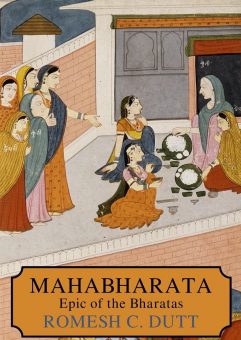This is monarch Dhrita-rashtra who doth o’er Gandharvas reign,
This is peerless archer Karna, erst on earth by Arjun slain,
Like the Sun in ruddy splendour, for the Sun inspired his birth,
As the son of chariot-driver he was known upon the earth!
’Midst the Sadhyas and the Maruts, ’midst immortals pure and bright
Seek thy friends the faithful Vrishnis matchless in their warlike might.
Seek and find the brave Satyaki who upheld thy cause so well,
Seek the Bhojas and Andhakas who in Kuru-kshetra fell!
This is gallant Abhimanyu whom the fair Subhadra bore,
Still unconquered in the battle, slain by fraud in yonder shore,
Abhimanyu son of Arjun, wielding Arjun’s peerless might,
With the Lord of Night he ranges, beauteous as the Lord of Night!
This, Yudhishthir, is thy father, by thy mother joined in heaven,
Oft he comes into my mansions in his flowery chariot driven,
[369] This is Bhishma stainless warrior, by the Vasus is his place.
By the god of heavenly wisdom teacher Drona sits in grace!
These and other mighty warriors in the earthly battle slain,
By their valour and their virtue walk the bright ethereal plain,
They have cast their mortal bodies, crossed the radiant gate of heaven,
For to win celestial mansions unto mortals it is given,
Let them strive by kindly action, gentle speech, endurance long, –
Brighter life and holier future unto sons of men belong!”
Translator’s Epilogue
[370] Ancient India, like ancient Greece, boasts of two great Epics. One of them, the Maha-bharata, relates to a great war in which all the warlike races of Northern India took a share, and may therefore be compared to the Iliad. The other, the Ramayana, relates mainly to the adventures of its hero, banished from his country and wandering for long years in the wildernesses of Southern India, and may therefore be compared to the Odyssey. It is the first of these two Epics, the Iliad of Ancient India, which is the subject of the foregoing pages.
The great war which is the subject of this Epic is believed to have been fought in the thirteenth or fourteenth century before Christ. For generations and centuries after the war its main incidents must have been sung by bards and minstrels in the courts of Northern India. The war thus became the centre of a cycle of legends, songs, and poems in ancient India, even as Charlemagne and Arthur became the centres of legends in mediaeval Europe. And then, probably under the direction of some enlightened king, the vast mass of legends and poetry, accumulated during centuries, was cast in a narrative form and formed the Epic of the Great Bharata nation, and therefore called the Maha-bharata. The real facts of the war had been obliterated by age, legendary heroes had become the principal actors, and, as is invariably the case in India, the thread of a high moral purpose, of the triumph of virtue and the subjugation of vice, was woven into the fabric of the great Epic.
We should have been thankful if this Epic, as it was thus originally put together some centuries before the Christian era, had been preserved to us. But this was not to be. The Epic became so popular that it went on growing with the growth of centuries. Every generation of poets had something to add; every distant [371] nation in Northern India was anxious to interpolate some account of its deeds in the old record of the international war; every preacher of a new creed desired to have in the old Epic some sanction for the new truths he inculcated. Passages from legal and moral codes were incorporated in the work which appealed to the nation much more effectively than dry codes; and rules about the different castes and about the different stages of the human life were included for the same purpose. All the floating mass of tales, traditions, legends, and myths, for which ancient India was famous, found a shelter under the expanding wings of this wonderful Epic; and as Krishna worship became the prevailing religion of India after the decay of Buddhism, the old Epic caught the complexion of the times, and Krishna-cult is its dominating religious idea in its present shape. It is thus that the work went on growing for a thousand years after it was first compiled and put together in the form of an Epic; until the crystal rill of the Epic itself was all but lost in an unending morass of religious and didactic episodes, legends, tales, and traditions.
When the mischief had been done, and the Epic had nearly assumed its present proportions, a few centuries after Christ according to the late Dr. Bühler, an
Pages: 1 2 3 4 5 6 7 8 9 10 11 12 13 14 15 16 17 18 19 20 21 22 23 24 25 26 27 28 29 30 31 32 33 34 35 36 37 38 39 40 41 42 43 44 45 46 47 48 49 50 51 52 53 54 55 56 57 58 59 60 61 62 63 64 65 66 67 68 69 70 71 72 73 74 75 76 77 78 79 80 81




